Imperial Japanese Navy Air Service
| Imperial Japanese Navy Air Service (IJNAS) 大日本帝國海軍航空隊 (Dai-Nippon Teikoku Kaigun Koku Tai) | |
|---|---|
|
| |
| Active | 1912–1945 |
| Country |
|
| Allegiance |
|
| Branch |
|
| Type | Naval Air service |
| Engagements |
World War I Sino-Japanese War World War II |
| Commanders | |
| Notable commanders | Chuichi Nagumo, Minoru Genda, Saburō Sakai, Mitsuo Fuchida |
| Insignia | |
| Roundel |
 |

The Imperial Japanese Navy Air Service (大日本帝國海軍航空隊 Dai-Nippon Teikoku Kaigun Kōkū-tai) was the air arm of the Imperial Japanese Navy during World War II. The organization was responsible for the operation of naval aircraft and the conduct of aerial warfare in the Pacific War.
It was controlled by the Navy Staff of the Imperial Japanese Navy and the Navy Ministry. The Imperial Japanese Navy Air Service was equal in function to the Royal Navy's Fleet Air Arm (FAA), the Italian Navy's Aviazione Navale, or the Soviet Navy's Morskaya Aviatsiya.
The Imperial Japanese Navy Aviation Bureau (Kaigun Kōkū Hombu) of the Ministry of the Navy of Japan was responsible for the development and training.
The Japanese military acquired their first aircraft in 1910 and followed the development of air combat during World War I with great interest. They initially procured European aircraft but quickly built their own and launched themselves onto an ambitious aircraft carrier building program. They launched the world's first purpose-built aircraft carrier, Hōshō, in 1922. Afterwards they embarked on a conversion program of several excess battlecruisers and battleships into aircraft carriers. The IJN Air Service had the mission of national air defence, deep strike, naval warfare, and so forth. It retained this mission to the end.
The Japanese pilot training program was very selective and rigorous, producing a high-quality and long-serving pilot corps, who ruled the air in the Pacific during early World War II. However, the long duration of the training program, combined with a shortage of gasoline for training, did not allow the Navy to rapidly provide qualified replacements in sufficient numbers. Moreover, the Japanese, unlike the U.S. or Britain, proved incapable of altering the program to speed up training of the recruits they got. The resultant decrease in quantity and quality, among other factors, resulted in increasing casualties toward the end of the war.
Japanese navy aviators, like their Army counterparts, preferred maneuverable aircraft, leading to lightly built but extraordinarily agile types, most famously the A6M Zero, which achieved its feats by sacrificing armor and self-sealing fuel tanks.
History
Origins

In 1912, the Royal Navy had informally established its own flying branch, the Royal Naval Air Service. The Japanese admirals, whose own Navy had been modeled on the Royal Navy and whom they admired, themselves proposed their own Naval Air Service. The Japanese Navy had also observed technical developments in other countries and saw that the airplane had potential. The following year, in 1913 a Navy transport ship, the Wakamiya was converted into a seaplane tender, a number of aircraft were also purchased.
Siege of Tsingtao

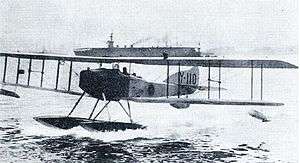
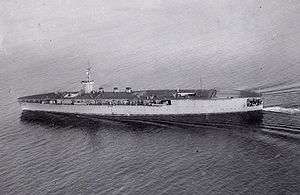
On 23 August 1914, as a result of its treaty with Great Britain, Japan declared war on Germany. The Japanese, together with a token British force, then laid siege to the German held territory of Kiaochow and its administrative capital Tsingtao on the Shandong peninsula. During the siege, starting from September, Maurice Farman seaplanes onboard (two active and two reserve) the Wakamiya conducted reconnaissance and aerial bombardments on German positions and ships. On 30 September the Wakamiya was later damaged by a mine, but the seaplanes (by transferring to land) continued to be used against the German defenders until their surrender on 7 November 1914. The Wakamiya conducted the world's first naval-launched aerial raids in history[N 1] and was in effect the first aircraft carrier of the Imperial Japanese Navy.[N 2] By the end of the siege the aircraft had conducted 50 sorties and dropped 200 bombs, although damages to German defenses were light.[2]
Interwar Years
The Japanese navy had closely monitored the progress of aviation of the three Allied naval powers during World War I and concluded that Britain had made the greatest advances in naval aviation[3]
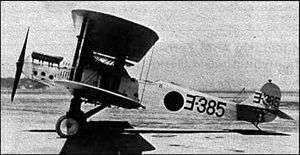
The Sempill Mission was a British aeronaval technical mission led by Captain Sempill and sent to Japan in September 1921, with the objective of helping the Imperial Japanese Navy develop its aeronaval forces. The mission consisted in a group of 29 British instructors, headed by Captain William Sempill, and stayed in Japan for 18 months.[4] The British government hoped it would lead to lucrative an arms deal. The Japanese, were trained on several British aircraft, such as the Gloster Sparrowhawk, in various techniques such as torpedo bombing, flight control and carrier landing and take-offs. Skills that would later be employed in the shallow waters of Pearl Harbor in December 1941.[5] The mission also brought the plans of the most recent British aircraft carriers, such as the HMS Argus and the HMS Hermes, which influenced the final stages of the development of the carrier Hōshō. The Hōshō became the first designed aircraft carrier from the keel up to be built. The military in Japan were also aided in their quest to build up their naval forces by Sempill who had become a Japanese spy. Over the next 20 years, the British Peer provided the Japanese with secret information on the latest British aviation technology. His espionage work helped the Japanese rapidly develop its military aircraft and its technologies before the Second World War.[6]
Under the Washington Naval Treaty two incomplete battlecruisers were allowed to be rebuilt as carriers, for the Japanese; the Akagi and the Amagi. However the Amagi was damaged during an earthquake in 1923 and the Kaga became a replacement. With these two carriers much of Imperial Japanese Navy's doctrines and operating procedures were established.
Sino-Japanese War
From the onset of hostilities in 1937 until forces were diverted to combat the Americans in 1941, the Imperial Japanese Navy Air Service played a key role in military operations on the Chinese mainland. Despite the fierce rivalry between military branches, in the fall of 1937 General Matsui Iwane, the Army general in command of the theater, admitted the superiority of the Naval Air Services. His combat troops relied on the Navy for air support.[7]
Aircraft attacked Chinese positions in Shanghai and surrounding areas, naval bombers such as the Mitubishi G3M and Mitsubishi G4M were used to bomb Chinese cities. Japanese fighter planes, notably the Mitsubishi Zero, gained tactical air superiority; control of the skies over China belonged to the Japanese. Unlike other naval airforces, the IJNAS was responsible strategic bombing and operated long ranged bombers.
The Japanese strategic bombing were mostly done against Chinese big cities, such as Shanghai, Wuhan and Chonging, with around 5,000 raids from February 1938 to August 1943.
The bombing of Nanjing and Guangzhou, which began on 22 and 23 September 1937, called forth widespread protests culminating in a resolution by the Far Eastern Advisory Committee of the League of Nations. Lord Cranborne, the British Under-Secretary of State For Foreign Affairs, expressed his indignation in his own declaration.
| “ | Words cannot express the feelings of profound horror with which the news of these raids had been received by the whole civilized world. They are often directed against places far from the actual area of hostilities. The military objective, where it exists, seems to take a completely second place. The main object seems to be to inspire terror by the indiscriminate slaughter of civilians...»[8] | ” |
World War II
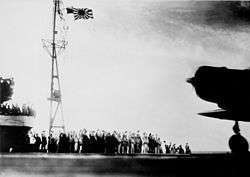


At the beginning of the Pacific war the Navy Air Service consisted of five naval air fleets[9] In April, 1941 the First Air Fleet was created, concentrating the Navy's carriers into a single powerful striking unit[10] The Japanese had a total of ten aircraft carriers: six fleet carriers, three smaller carriers, and one training carrier. The 11th Air Fleet (Imperial Japanese Navy): contained most of the Navy's land based strike aircraft.
On December 7, 1941, the Imperial Japanese Navy attacked Pearl Harbor, crippling the U.S Pacific Fleet by destroying over 188 aircraft and only losing 29 of their own aircraft. On December 10, land based bombers of the 11th Airfleet were also able to sink HMS Prince of Wales and HMS Repulse. There were also air raids on the Philippines and Darwin in northern Australia.
In these battles, the Japanese veterans of the Chinese war did well against inexperienced Allied pilots flying obsolescent aircraft. However, their advantage did not last. In the Battle of the Coral Sea, the Battle of Midway, and again in the Guadalcanal Campaign, the Japanese lost many veteran pilots. Because the Japanese pilot training program was unable to increase its production rate, those veterans could not be replaced. Meanwhile, the American pilot training program went from strength to strength. The American aircraft industry rapidly increased production rates of new designs that rendered their Japanese opponents obsolescent. Examination of crashed or captured Japanese aircraft revealed that they achieved their superior range and maneuverability by doing without cockpit armor and self-sealing fuel tanks. Flight tests showed that they lost maneuverability at high speeds. American pilots were trained to take advantage of these weaknesses. The outdated Japanese aircraft and poorly trained pilots suffered great losses in any air combat for the rest of the war, particularly in the Great Marianas Turkey Shoot. In the Battle of Leyte Gulf a few months later, the First Air Fleet was used only as a decoy force to draw the main American fleet away from Leyte. The remnants of Japanese naval aviation were then limited to land-based operations, increasingly characterized by kamikaze attacks on American invasion fleets.
From 16 December 1941 to 20 March 1945 IJN aviation casualties killed were 14,242 aircrew and 1,579 officers.
Aircraft strength 1941
The IJNAS had over 3,089 aircraft in 1941 and 370 trainers.
- 1,830 first line aircraft including:
- 660 fighters, 350 Mitsubishi Zeros[11]
- 330 Carrier based strike aircraft
- 240 land based twin engined bombers
- 520 seaplanes (includes fighters and reconnaissance) and flying boats.
World War II Aircraft
Fighters:
- Mitsubishi A5M (Navy Type 96 Carrier Fighter) Claude
- Mitsubishi A6M (Navy Type 0 Carrier Fighter) Zeke
- Kawanishi N1K-J/N1K2-J (Navy Land-based Interceptor Fighter 'Shiden'/'Shiden Kai') George
- Mitsubishi J2M (Navy-Land based Interceptor Fighter 'Raiden') Jack
- Nakajima J1N1-S (Navy Night Fighter 'Gekko') Irving
Bombers:
- Yokosuka P1Y (Navy bomber 'Ginga') Frances
- Mitsubishi G4M (Navy Type 1 Land-based Attack Bomber) Betty
- Mitsubishi G3M (Navy Type 96 Land-based Attack Bomber 'Rikko') Nell
Torpedo & Dive Bombers:
- Aichi D1A (Navy Type 94/96 Carrier Bomber) Susie
- Aichi D3A (Navy Type 99 Carrier Bomber) Val
- Yokosuka D4Y (Navy Type 33 Carrier Bomber 'Suisei') Judy
- Nakajima B5N (Navy Type 97 Carrier Attack Bomber) Kate
- Nakajima B6N (Navy Type 11 Carrier Attack Bomber 'Tenzan') Jill
- Yokosuka B4Y (Navy Type 96 Carrier Attack Bomber) Jean
Float planes & Flying Boats
- Aichi E13A (Navy Type 0 Reconnaissance Seaplane) Jake
- Yokosuka E14Y (Navy Type 0 Small Reconnaissance Seaplane) Glen
- Aichi E16A (Navy Type 16 Reconnaissance Seaplane 'Zuiun') Paul
- Mitsubishi F1M (Navy Type 0 Observation Seaplane) Pete
- Nakajima E8N (Navy Type 95 Reconnaissance Seaplane) Dave
- Kawanishi E7K (Navy Type 94 Reconnaissance Seaplane) Alf
- Kawanishi H8K (Navy Type 2 Large Flying Boat) Emily
- Kawanishi H6K (Navy Type 97 Large Flying Boat) Mavis
- Kawanishi N1K1 (Navy Fighter Seaplane 'Kyōfū') Rex
- Nakajima A6M2-N (Navy Type 2 Interceptor/Fighter-Bomber Seaplane) Rufe
Reconnaissance Planes:
- Nakajima C6N (Navy Carrier Reconnaissance Plane 'Saiun') Myrt
Trainers:
- Mitsubishi A5M4-K (Navy Type 2 Training Fighter)
Transports:
- Mitsubishi L4M1 (Navy Type 0 Transport) Topsy
- Nakajima L1N1 (Navy Type 97 Transport) Thora
- Nakajima G5N (Navy Experimental 13-Shi Attack Bomber 'Shinzan') Liz (used as transports)
Organization
Carrier aviation flotillas
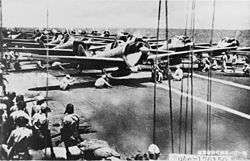
The elite of the pilots were the carrier-based air groups (Kōkūtai, later called koku sentai) whose size (from a handful to 80 or 90 aircraft) was dependent on both the mission and type of aircraft carrier that they were on. Fleet carriers had three types of aircraft: fighters, level/torpedo planes, and dive bombers. Smaller carriers tended to have only two types, fighters and dive bombers. The carrier-based Kōkūtai numbered over 1,500 pilots and just as many aircraft at the beginning of the Pacific War.
Eleventh Air Fleet and land-based air fleets
The IJN also maintained a shore-based system of naval air fleets called Koku Kantai and area air fleets called homen kantai containing mostly twin-engine bombers and seaplanes. The senior command was the Eleventh Naval Air Fleet, commanded by Vice Admiral Nishizō Tsukahara. Land based aircraft provided the bulk of Japan's naval aviation up to the eve of World War II.[12]
Strength
Each naval air fleet contained one or more naval air flotillas (commanded by Rear Admirals) each with two or more naval air groups. Each naval air group consisted of a base unit and 12 to 36 aircraft, plus four to 12 aircraft in reserve. Each naval air group consisted of several hikotai (squadron/s) of nine, 12 or 16 aircraft; this was the main IJN Air Service combat unit and was equivalent to a chutai in the Imperial Japanese Army Air Service. Each hikotai was commanded by a Lieutenant (j.g.), Warrant Officer, or experienced Chief Petty Officer, while most pilots were non-commissioned officers. There were usually four sections in each hikotai, and each section (shotai) with three or four aircraft; by mid-1944 it was common for a shotai to have four aircraft. There were over 90 naval air groups at the start of the Pacific War, each assigned either a name or a number. The named naval air groups were usually linked to a particular navy air command or a navy base. They were usually numbered when they left Japan.
.svg.png)
| ||||||||||||||||||||
Naval Air Group identification
And before 31 October 1942
- Place name; Standing air group (常設航空隊, Jōsetsu-Kōkūtai).
- Numbered name; Special setting air group (特設航空隊, Tokusetsu-Kōkūtai).
And after 1 November 1942
- Numbered name; Category 'A' air group (甲航空隊, Kō Kōkūtai) as combatant unit.
- Example
- 12th Kōkūtai is Training (bomber) group.
- 121st Kōkūtai is reconnaissance aircraft group.
- 762nd Kōkūtai is land-based torpedo bomber group.
- 1081st Kōkūtai is military airlift group.
- Regulation table
- Example
| Value | Hundred's digit (classification) | Ten's digit (competent authorities) | One's digit |
|---|---|---|---|
| 0 | Training group | Yokosuka Naval District | Odd number is standing air group. Even number is special setting air group. |
| 1 | Reconnaissance aircraft group | ||
| 2 | Fighter group (carrier fighter) | ||
| 3 | Fighter group (interceptor fighter) | Kure Naval District | |
| 4 | Float reconnaissance aircraft group | ||
| 5 | Carrier dive bomber group, carrier torpedo bomber group | Sasebo Naval District | |
| 6 | Carrier air group, submarine-launched floatplane group | ||
| 7 | Land-based bomber group, land-based attack bomber group | ||
| 8 | Flying boat group | Maizuru Naval District | |
| 9 | Maritime patrol aircraft (Maritime Escort) group | ||
| 10 | Military airlift group |
- Place name; Category 'A' air group as training unit, evaluation unit.
- Example
- Atsugi Kōkūtai
- Kasumigaura Kōkūtai
- Takuma Kōkūtai
- Yokosuka Kōkutai
- Example
- Region name; Category 'B' air group (乙航空隊, Otsu Kōkūtai) as air base guard unit.
Squadron identification
And after 1 March 1944
- Regulation table
| Classification | Squadron number | Aircraft type (role) |
|---|---|---|
| Fighter Squadron (戦闘飛行隊 Sentō Hikōtai) | 1–400 | Type 'A' Fighter or carrier fighter (甲戦 Kōsen) |
| 401–800 | Type 'B' Fighter (乙戦 Otsusen, interceptor fighter) | |
| 801–1000 | Type 'C' Fighter (丙戦 Heisen, night fighter) | |
| Attack Squadron (攻撃飛行隊 Kōgeki Hikōtai) | 1–200 | Carrier dive-bomber |
| 201–400 | Carrier attack-bomber | |
| 401–600 | Land-based bomber | |
| 601–800 | Land-based attack-bomber | |
| Reconnaissance Squadron (偵察飛行隊 Teisatsu Hikōtai) | 1–200 | Reconnaissance aircraft |
| 201–300 | Flying boat | |
| 301–600 | Reconnaissance seaplane | |
| 601–800 | (missing number) | |
| 801–1000 | Maritime patrol aircraft | |
| Transport Squadron (挺進飛行隊 Teishin Hikōtai) | 1–100 | Transport |
Naval Aircraft identification System
The IJN had, at the beginning of the Pacific War, three aircraft designation systems:[13] The Experimental Shi (試)numbers, the Type numbering system and an aircraft designation system broadly similar to that used by the U.S. Navy from 1922 until 1962.
Each new design was first given an experimental Shi number, based upon the current Japanese imperial year of reign. The Mitsubishi Zero so started its career as Navy Experimental 12-Shi Carrier Fighter (海軍十二試艦上戦闘機).[14]
Upon entering production the aircraft was given a Type number. The 'Zero' was so fully known as Navy Type 0 Carrier Fighter (海軍零式艦上戦闘機), as the Zero was accepted in 1940, or 2600 in the Japanese calendar.[15]
The aircraft was also given a "short designation" consisting of a group of Roman letters and numbers.
- The first letter (sometimes two) indicated the basic type or purpose of the aircraft.
- Second came a series number indicating the number of major sub-types produced for that type of aircraft. (Unlike USN practice, the digit "1" was not ignored in this system and was included.)
- Third was the second letter which was the manufacturer's code, and included some non-Japanese companies.
(G4M designated attack bomber (G), the fourth in the Navy's sequence, designed or produced by Mitsubishi, while G5N would be the next attack bomber in sequence, built by Nakajima.)
- Fourth was a number indicating the version of the aircraft.
The first production version of the 'Zero' thus became A6M1.
| Letter | Type | Manufacturer |
|---|---|---|
| A | Carrier Fighter | Aichi (Aichi Tokei Denki and Aichi Kokuki)/North American Aviation (US) |
| B | Carrier Attack Bomber (Torpedo or Level Bomber) | Boeing Aircraft (US) |
| C | Carrier Reconnaissance | Consolidated Aircraft (US) |
| D | Carrier Bomber (Dive Bomber) | Douglas Aircraft (US) |
| E | Reconnaissance Seaplane | - |
| F | Observation Seaplane | - |
| G | Attack Bomber (land based) | Hitachi Kokuki/Grumman Aircraft Engineering (US) |
| H | Flying Boat (Reconnaissance) | Hiro (Dai-Juichi Kaigun Koskusho)/Hawker Aircraft (UK) |
| He | - | Ernst Heinkel Flugzeugwerke (Germany) |
| J | Land-based Fighter | Nihon Kogata Hikoki/Junkers Flugzeug und Moterenwerke (Germany) |
| K | Trainer | Kawanishi Kokuki |
| L | Transport | - |
| M | Special Floatplane | Mitsubishi Jukogyo |
| MX | Special Purpose Aircraft | - |
| N | Float Fighter | Nakajima Hikoki |
| P | Bomber (land based) | Nihon Hikoki |
| Q | Patrol Plane (Anti-Submarine Warfare) | - |
| R | Land-based Reconnaissance | - |
| S | Night Fighter | Sasebo (Dai-Nijuichi Kaigun Kokusho) |
| Si | - | Showa Hikoki |
| V | - | Vought-Sikorsky (US) |
| W | - | Watanabe Tekkosho/Kyushu Hikoki |
| Y | - | Yokosuka (Dai-Ichi Kaigun Koku Gijitsusho) |
| Z | - | Mizuno Guraida Seisakusho |
Further minor changes were indicated by adding letters after the subtype number as in the Type/Model scheme above. The first two letters and the series number remained the same for the service life of each design.
In a few cases, when the designed role of an aircraft changed, the new use was indicated by adding a dash and a second type letter to the end of the existing short designation (e.g., the H6K4 was the sixth flying boat (H6) designed by Kawanishi (K), fourth version of that design (4). When the plane was equipped primarily as a troop or supply transport, its designation was H6K4-L.)
See also
- List of military aircraft of Japan
- Imperial Japanese Navy Aviation Bureau
- Imperial Japanese Army Air Force
- List of A6M Reisen operators
- List of Japanese Navy Air Force aces (Mitsubishi A6M)
- Daitai Transport Unit
- List of radar models of the Imperial Japanese Navy
- List of bombs used by the Imperial Japanese Navy
- List of weapons on Japanese combat aircraft
- List of Aircraft engines in use of Japanese Navy Air Force
- Japanese marine paratroopers of World War II
- Giretsu special forces operations
- WWII Battle of Japan (Air War)
References
Notes
Citations
- 1 2 Source:GlobalSecurity.org
- ↑ Peattie 2007, p. 9.
- ↑ Peattie 2007, p. 17.
- ↑ Peattie 2007, p. 19.
- ↑ "The Highland peer who prepared Japan for war". The Daily Telegraph. 6 January 2002.
- ↑ Day, Peter (3 January 2002). "British aviation pioneer was a spy for Japan". Daily Telegraph. Retrieved 2012-05-21.
- ↑ Peattie 2007, p. 103.
- ↑ Gilbert 1989, p. 135.
- ↑ Air Units of the Imperial Japanese Navy, Globalsecurity.com
- ↑ Tagaya 2003, p. 5.
- ↑ Sweet creative, 2009. p. 199.
- ↑ Peattie 2007, p. 29.
- ↑ Francillon 1979, p. 50.
- ↑ Francillon 1979, p. 546.
- ↑ Francillon 1979, p. 52.
- ↑ Francillon 1979, pp. 51-52, 549-557.
- ↑ Thorpe 1977, p. 15.
Bibliography
- Francillon, Ph.D., René J. Japanese Aircraft of the Pacific War. London: Putnam & Company Ltd., 1970. ISBN 0-370-00033-1 (2nd edition 1979, ISBN 0-370-30251-6).
- Gilbert, Martin (ed.). Illustrated London News: Marching to War, 1933-1939. New York: Doubleday, 1989.
- Peattie, Mark R. Sunburst: The Rise of Japanese Naval Air Power, 1909-1941. Annapolis, MD: US Naval Institute Press, 2007. ISBN 978-1-59114-664-3.
- Stille, Mark. Imperial Japanese Navy Aircraft Carriers, 1921-45. Botley, Oxfordshire, UK: Osprey Publishing, 2005. ISBN 1-84176-853-7.
- Tagaya, Osamu. Imperial Japanese Navy Aviator, 1937-45. Botley, Oxfordshire, UK: Osprey Publishing, 2003. ISBN 1-84176-385-3.
- Tagaya, Osamu. Mitsubishi Type 1 "Rikko" 'Betty' Units of World War 2. Botley, Oxfordshire, UK: Osprey Publishing, 2001. ISBN 978-1-84176-082-7.
Further reading
- Thorpe, Donald W. Japanese Naval Air Force Camouflage and Markings World War II. Fallbrook, CA: Aero Publishers, Inc., 1977. ISBN 0-8168-6583-3 (hardcover, paperback ISBN 0-8168-6587-6).
- Tagaya, Osamu: "The Imperial Japanese Air Forces", In: Higham & Harris. Why Air Forces Fail: The Anatomy of Defeat. University Press of Kentucky
- Sweet creative (ed.). Zerosen no himitsu. PHP kenkyusho, 2009. ISBN 978-4-569-67184-0.
- Assignment of naval air group numbers (海軍航空隊番号附与標準, Kaigun Kōkūtai-bangō fuyo Hyōjun), 1 November 1942, Naval Minister's Secretariat, Ministry of the Navy
- Senshi Sōsho, Asagumo Simbun (Japan)
- Vol. 39, Combined Fleet #4, "First part of the Third step Operations", 1970
- Vol. 45, Combined Fleet #6, "Latter part of the Third step Operations", 1971
- Vol. 71, Combined Fleet #5, "Middle part of the Third step Operations", 1974
- Vol. 77, Combined Fleet #3, "Until February 1943", 1974
- Vol. 80, Combined Fleet #2, "Until June 1942", 1975
- Vol. 91, Combined Fleet #1, "Until outbreak of war", 1975
- Vol. 93, Combined Fleet #7, "Last part of the War", 1976
- Vol. 95, History and summary of the Imperial Japanese Navy Air Service, 1976
External links
- http://www.combinedfleet.com/kaigun.htm (see the section of Japanese Navy Aircraft)
- http://www.warbirdpix.com/ (link with somes photos of Axis Aircraft (German, Italian and Japanese Army and Navy)
- http://www.j-aircraft.org/xplanes/ (about advanced Japanese Army and Navy aircraft)
- http://web.archive.org/web/20091027182301/http://uk.geocities.com/sadakichi09/ (over Japanese Navy and Army armaments, vehicles, Aircraft, electronic warfare and somes local special Japanese weapon technology )
- http://www.j-aircraft.com/captured/ (somes captured aircraft or aircraft in evaluations)
- http://www.j-aircraft.com/ (general resources of Japanese aircraft)
